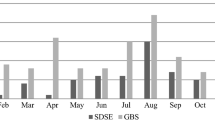Abstract
The number of patients with severe invasive infections (mainly exhibiting bacteremia) with Streptococcus dysgalactiae subsp. equisimilis (SDSE) has been increasing worldwide. We herein report the clinical aspects of invasive infections (cellulitis, pneumonia, and urosepsis) occurring with SDSE in 13 elderly patients (mean age 84 years, range 69–99 years) diagnosed at a hospital for elderly individuals during the period January 2005–June 2009. Ten subjects had underlying diseases, including neurologic disorders, diabetes mellitus, and others. Eleven patients presented to the hospital emergency department, and the most common symptom was high fever or respiratory distress. Primary care and emergency department doctors treating elderly patients with high fever should keep in mind invasive SDSE infection as a differential diagnosis, especially when an elderly person has underlying illnesses. To detect SDSE in elderly subjects, blood cultures should be obtained before the administration of antimicrobials because, as we found, the patients’ symptoms were limited.
Similar content being viewed by others
References
Vandamme P, Pot B, Falsen E, Kersters K, Devriese LA. Taxonomic study of Lancefield streptococcal groups C, G, and L (Streptococcus dysgalactiae) and proposal of S. dysgalactiae subsp. equisimilis subsp. nov. Int J Syst Bacteriol. 1996;46:774–81.
Sunaoshi K, Murayama SY, Adachi K, Yagoshi M, Okuzumi K, Chiba N, et al. Molecular emm genotyping and antibiotic susceptibility of Streptococcus dysgalactiae subsp. equisimilis isolated from invasive and noninvasive infections. J Med Microbiol. 2010;59:82–8. doi:10.1099/jmm.0.013201-0.
Ikebe T, Murayama S, Saitoh K, Yamai S, Suzuki R, Isobe J, et al. Surveillance of severe invasive group-G streptococcal infections and molecular typing of the isolates in Japan. Epidemiol Infect. 2004;132:145–9.
Broyles LN, Van Beneden C, Beall B, Facklam R, Shewmaker PL, Malpiedi P, et al. Population-based study of invasive disease due to β-hemolytic streptococci of groups other than A and B. Clin Infect Dis. 2009;48:706–12.
Sunaoshi K, Aburahashi H, Kobayashi R, Yamamoto Y, Okuzumi K, Yoshida A, et al. Emm typing by genetic identification of Streptococcus dysgalactiae subsp. equisimilis and susceptibility to oral antibiotics. Kansenshogaku Zasshi. 2006;80:488–95.
Murayama SY, Seki C, Sakata H, Sunaoshi K, Nakayama E, Iwata S, et al. Capsular type and antibiotic resistance in Streptococcus agalactiae isolates from patients with invasive infections, ranging from newborns to the elderly. Antimicrob Agents Chemother. 2009;53:2650–3.
Siljander T, Karppelin M, Vähäkuopus S, Syrjänen J, Toropainen M, Kere J, et al. Acute bacterial, nonnecrotizing cellulitis in Finland: microbiological findings. Clin Infect Dis. 2008;46:855–61.
Matsui D, Kitasato Y, Honda S, Ueno K, Tanaka A, Edakuni N, et al. A case of bacterial pneumonia caused by Streptococcus dysgalactiae subsp. equisimilis, showing patchy consolidations resembling organizing pneumonia. Nihon Kokyuki Gakkai Zasshi. 2007;45:36–42.
Ueno K, Kawayama T, Edakuni N, Koga T, Aizawa H. A case of thoracic empyema with gas formation associated with Streptococcus dysgalactiae subsp. equisimilis. Kansenshogaku Zasshi. 2006;80:527–30.
Skogberg K, Simonen H, Renkonen OV, Valtonen VV. Beta-haemolytic group A, B, C and G streptococcal septicaemia: a clinical study. Scand J Infect Dis. 1988;20:119–25.
Ekelund K, Skinhøj P, Madsen J, Konradsen HB. Invasive group A, B, C and G streptococcal infections in Denmark 1999–2002: epidemiological and clinical aspects. Clin Microbiol Infect. 2005;11:569–76.
Takahashi T, Sunaoshi K, Sunakawa K, Fujishima S, Watanabe H, Ubukata K. Clinical aspects of invasive infections with Streptococcus dysgalactiae ssp. equisimilis in Japan: differences with respect to Streptococcus pyogenes and Streptococcus agalactiae infections. Clin Microbiol Infect. doi:10.1111/j.1469-0691.2009.03047.x.
Acknowledgments
This study was funded in part by a grant under the category, ‘‘Research Project for Emerging and Re-emerging Infectious Diseases’’ (H-19-002), from the Japanese Ministry of Health, Labour and Welfare (to Dr. K. Ubukata) and a Grant-in-Aid for Scientific Research (B) from the Ministry of Education, Culture, Sports, Science and Technology of Japan (number 21390306, to Dr. T. Takahashi). The authors thank Akiko Ono, Keisuke Okada, and Miho Yoshino for assistance with the manuscript preparation.
Author information
Authors and Affiliations
Corresponding author
About this article
Cite this article
Takahashi, T., Asami, R., Tanabe, K. et al. Clinical aspects of invasive infection with Streptococcus dysgalactiae subsp. equisimilis in elderly patients. J Infect Chemother 16, 68–71 (2010). https://doi.org/10.1007/s10156-009-0016-1
Received:
Accepted:
Published:
Issue Date:
DOI: https://doi.org/10.1007/s10156-009-0016-1




